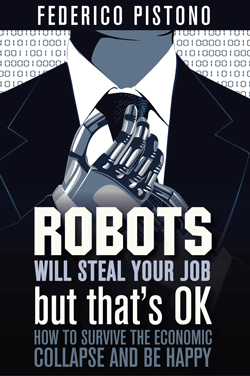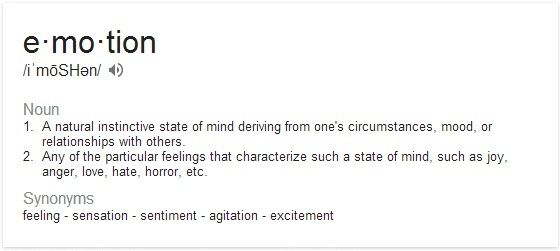We have come to believe that we are dependent on governments and corporations for everything, and now that technology is ever more pervasive, our dependence on them is even stronger. And of course we don’t question the cycle of labor-for-income, income-for-survival and the conspicuous consumption model that has become dominant in virtually every country – and that not only is ecologically unsustainable, but it also generates immense income inequality.
Well, I do. I challenge the assumption that we should live to work, and even that we should work to live, for that matter. In an age where we already produce more than enough food, energy, and drinkable water for 7 billion people with little to no human labour, while 780 million lack access to clean water and 860 million are suffering from chronic hunger, it follows that the system we have in place isn’t allocating resources efficiently. And rather than going back to outdated ideologies (i.e. socialism), we can try new forms of societal structure; starting with open source philosophy, shared knowledge, self-reliance, and sustainable communities.
There are many transitional steps that we can take – reduced workweek, reform patent and copyright laws, switch to distributed and renewable energies – and there will be bumps along the road, no doubt. But if we move in the right direction, if we are ready to abandon ideologies and stick to whatever works best, I think we will prevail – simply because we will realise that there is no war other than the one we are fighting with ourselves.
]]>Introduction
Most thinkers speculating on the coming of an intelligence explosion (whether via Artificial-General-Intelligence or Whole-Brain-Emulation/uploading), such as Ray Kurzweil [1] and Hans Moravec [2], typically use computational price performance as the best measure for an impending intelligence explosion (e.g. Kurzweil’s measure is when enough processing power to satisfy his estimates for basic processing power required to simulate the human brain costs $1,000). However, I think a lurking assumption lies here: that it won’t be much of an explosion unless available to the average person. I present a scenario below that may indicate that the imminence of a coming intelligence-explosion is more impacted by basic processing speed – or instructions per second (ISP), regardless of cost or resource requirements per unit of computation, than it is by computational price performance. This scenario also yields some additional, counter-intuitive conclusions, such as that it may be easier (for a given amount of “effort” or funding) to implement WBE+AGI than it would be to implement AGI alone – or rather that using WBE as a mediator of an increase in the rate of progress in AGI may yield an AGI faster or more efficiently per unit of effort or funding than it would be to implement AGI directly.
Loaded Uploads:
Petascale supercomputers in existence today exceed the processing-power requirements estimated by Kurzweil, Moravec, and Storrs-Hall [3]. If a wealthy individual were uploaded onto an petascale supercomputer today, they would have the same computational resources as the average person would eventually have in 2019 according to Kurzweil’s figures, when computational processing power equal to the human brain, which he estimates at 20 quadrillion calculations per second. While we may not yet have the necessary software to emulate a full human nervous system, the bottleneck for being able to do so is progress in the field or neurobiology rather than software performance in general. What is important is that the raw processing power estimated by some has already been surpassed – and the possibility of creating an upload may not have to wait for drastic increases in computational price performance.
 The rate of signal transmission in electronic computers has been estimated to be roughly 1 million times as fast as the signal transmission speed between neurons, which is limited to the rate of passive chemical diffusion. Since the rate of signal transmission equates with subjective perception of time, an upload would presumably experience the passing of time one million times faster than biological humans. If Yudkowsky’s observation [4] that this would be the equivalent to experiencing all of history since Socrates every 18 “real-time” hours is correct then such an emulation would experience 250 subjective years for every hour and 4 years a minute. A day would be equal to 6,000 years, a week would be equal to 1,750 years, and a month would be 75,000 years.
The rate of signal transmission in electronic computers has been estimated to be roughly 1 million times as fast as the signal transmission speed between neurons, which is limited to the rate of passive chemical diffusion. Since the rate of signal transmission equates with subjective perception of time, an upload would presumably experience the passing of time one million times faster than biological humans. If Yudkowsky’s observation [4] that this would be the equivalent to experiencing all of history since Socrates every 18 “real-time” hours is correct then such an emulation would experience 250 subjective years for every hour and 4 years a minute. A day would be equal to 6,000 years, a week would be equal to 1,750 years, and a month would be 75,000 years.
Moreover, these figures use the signal transmission speed of current, electronic paradigms of computation only, and thus the projected increase in signal-transmission speed brought about through the use of alternative computational paradigms, such as 3-dimensional and/or molecular circuitry or Drexler’s nanoscale rod-logic [5], can only be expected to increase such estimates of “subjective speed-up”.
The claim that the subjective perception of time and the “speed of thought” is a function of the signal-transmission speed of the medium or substrate instantiating such thought or facilitating such perception-of-time follows from the scientific-materialist (a.k.a. metaphysical-naturalist) claim that the mind is instantiated by the physical operations of the brain. Thought and perception of time (or the rate at which anything is perceived really) are experiential modalities that constitute a portion of the brain’s cumulative functional modalities. If the functional modalities of the brain are instantiated by the physical operations of the brain, then it follows that increasing the rate at which such physical operations occur would facilitate a corresponding increase in the rate at which such functional modalities would occur, and thus the rate at which the experiential modalities that form a subset of those functional modalities would likewise occur.
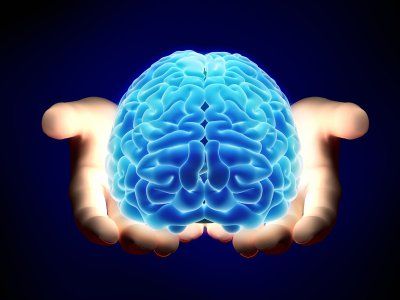 Petascale supercomputers have surpassed the rough estimates made by Kurzweil (20 petaflops, or 20 quadrillion calculations per second), Moravec (100,000 MIPS), and others. Most argue that we still need to wait for software improvements to catch up with hardware improvements. Others argue that even if we don’t understand how the operation of the brain’s individual components (e.g. neurons, neural clusters, etc.) converge to create the emergent phenomenon of mind – or even how such components converge so as to create the basic functional modalities of the brain that have nothing to do with subjective experience – we would still be able to create a viable upload. Nick Bostrom & Anders Sandberg, in their 2008 Whole Brain Emulation Roadmap [6] for instance, have argued that if we understand the operational dynamics of the brain’s low-level components, we can then computationally emulate such components and the emergent functional modalities of the brain and the experiential modalities of the mind will emerge therefrom.
Petascale supercomputers have surpassed the rough estimates made by Kurzweil (20 petaflops, or 20 quadrillion calculations per second), Moravec (100,000 MIPS), and others. Most argue that we still need to wait for software improvements to catch up with hardware improvements. Others argue that even if we don’t understand how the operation of the brain’s individual components (e.g. neurons, neural clusters, etc.) converge to create the emergent phenomenon of mind – or even how such components converge so as to create the basic functional modalities of the brain that have nothing to do with subjective experience – we would still be able to create a viable upload. Nick Bostrom & Anders Sandberg, in their 2008 Whole Brain Emulation Roadmap [6] for instance, have argued that if we understand the operational dynamics of the brain’s low-level components, we can then computationally emulate such components and the emergent functional modalities of the brain and the experiential modalities of the mind will emerge therefrom.
Mind Uploading is (Largely) Independent of Software Performance:
Why is this important? Because if we don’t have to understand how the separate functions and operations of the brain’s low-level components converge so as to instantiate the higher-level functions and faculties of brain and mind, then we don’t need to wait for software improvements (or progress in methodological implementation) to catch up with hardware improvements. Note that for the purposes of this essay “software performance” will denote the efficacy of the “methodological implementation” of an AGI or Upload (i.e. designing the mind-in-question, regardless of hardware or “technological implementation” concerns) rather than how optimally software achieves its effect(s) for a given amount of available computational resources.
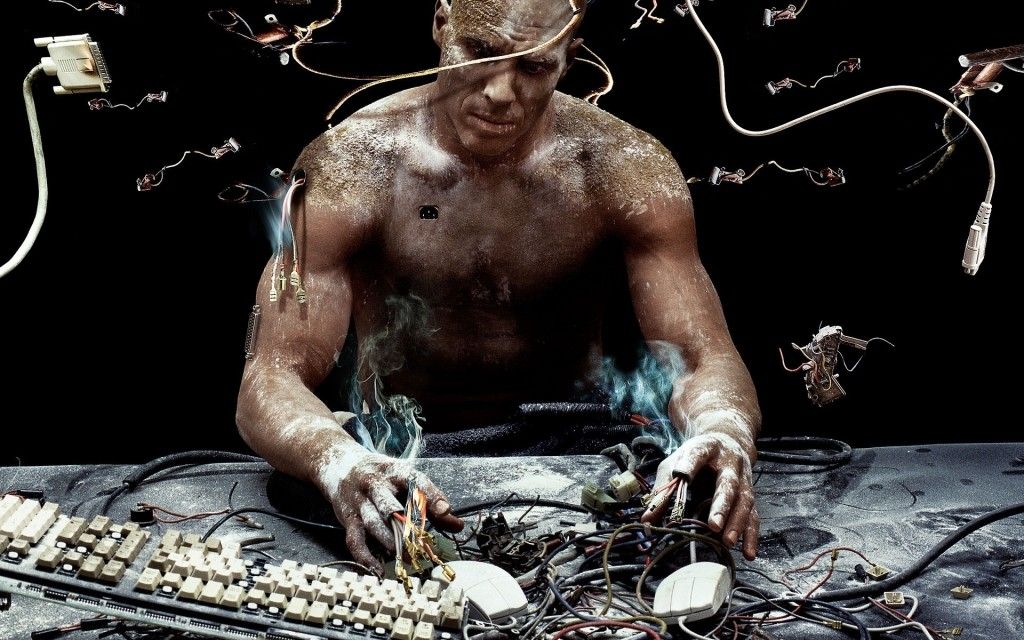 This means that if the estimates for sufficient processing power to emulate the human brain noted above are correct then a wealthy individual could hypothetically have himself destructively uploaded and run on contemporary petascale computers today, provided that we can simulate the operation of the brain at a small-enough scale (which is easier than simulating components at higher scales; simulating the accurate operation of a single neuron is less complex than simulating the accurate operation of higher-level neural networks or regions). While we may not be able to do so today due to lack of sufficient understanding of the operational dynamics of the brain’s low-level components (and whether the models we currently have are sufficient is an open question), we need wait only for insights from neurobiology, and not for drastic improvements in hardware (if the above estimates for required processing-power are correct), or in software/methodological-implementation.
This means that if the estimates for sufficient processing power to emulate the human brain noted above are correct then a wealthy individual could hypothetically have himself destructively uploaded and run on contemporary petascale computers today, provided that we can simulate the operation of the brain at a small-enough scale (which is easier than simulating components at higher scales; simulating the accurate operation of a single neuron is less complex than simulating the accurate operation of higher-level neural networks or regions). While we may not be able to do so today due to lack of sufficient understanding of the operational dynamics of the brain’s low-level components (and whether the models we currently have are sufficient is an open question), we need wait only for insights from neurobiology, and not for drastic improvements in hardware (if the above estimates for required processing-power are correct), or in software/methodological-implementation.
If emulating the low-level components of the brain (e.g. neurons) will give rise to the emergent mind instantiated thereby, then we don’t actually need to know “how to build a mind” – whereas we do in the case of an AGI (which for the purposes of this essay shall denote AGI not based off of the human or mammalian nervous system, even though an upload might qualify as an AGI according to many people’s definitions). This follows naturally from the conjunction of the premises that 1. the system we wish to emulate already exists and 2. we can create (i.e. computationally emulate) the functional modalities of the whole system by only understanding the operation of the low level-level components’ functional modalities.
Thus, I argue that a wealthy upload who did this could conceivably accelerate the coming of an intelligence explosion by such a large degree that it could occur before computational price performance drops to a point where the basic processing power required for such an emulation is available for a widely-affordable price, say for $1,000 as in Kurzweil’s figures.
Such a scenario could make basic processing power, or Instructions-Per-Second, more indicative of an imminent intelligence explosion or hard take-off scenario than computational price performance.
If we can achieve human whole-brain-emulation even one week before we can achieve AGI (the cognitive architecture of which is not based off of the biological human nervous system) and this upload set to work on creating an AGI, then such an upload would have, according to the “subjective-speed-up” factors given above, 1,750 subjective years within which to succeed in designing and implementing an AGI, for every one real-time week normatively-biological AGI workers have to succeed.
The subjective-perception-of-time speed-up alone would be enough to greatly improve his/her ability to accelerate the coming of an intelligence explosion. Other features, like increased ease-of-self-modification and the ability to make as many copies of himself as he has processing power to allocate to, only increase his potential to accelerate the coming of an intelligence explosion.
This is not to say that we can run an emulation without any software at all. Of course we need software – but we may not need drastic improvements in software, or a reinventing of the wheel in software design
 So why should we be able to simulate the human brain without understanding its operational dynamics in exhaustive detail? Are there any other processes or systems amenable to this circumstance, or is the brain unique in this regard?
So why should we be able to simulate the human brain without understanding its operational dynamics in exhaustive detail? Are there any other processes or systems amenable to this circumstance, or is the brain unique in this regard?
There is a simple reason for why this claim seems intuitively doubtful. One would expect that we must understand the underlying principles of a given technology’s operation in in order to implement and maintain it. This is, after all, the case for all other technologies throughout the history of humanity. But the human brain is categorically different in this regard because it already exists.
If, for instance, we found a technology and wished to recreate it, we could do so by copying the arrangement of components. But in order to make any changes to it, or any variations on its basic structure or principals-of-operation, we would need to know how to build it, maintain it, and predictively model it with a fair amount of accuracy. In order to make any new changes, we need to know how such changes will affect the operation of the other components – and this requires being able to predictively model the system. If we don’t understand how changes will impact the rest of the system, then we have no reliable means of implementing any changes.
Thus, if we seek only to copy the brain, and not to modify or augment it in any substantial way, the it is wholly unique in the fact that we don’t need to reverse engineer it’s higher-level operations in order to instantiate it.
This approach should be considered a category separate from reverse-engineering. It would indeed involve a form of reverse-engineering on the scale we seek to simulate (e.g. neurons or neural clusters), but it lacks many features of reverse-engineering by virtue of the fact that we don’t need to understand its operation on all scales. For instance, knowing the operational dynamics of the atoms composing a larger system (e.g. any mechanical system) wouldn’t necessarily translate into knowledge of the operational dynamics of its higher-scale components. The approach mind-uploading falls under, where reverse-engineering at a small enough scale is sufficient to recreate it, provided that we don’t seek to modify its internal operation in any significant way, I will call Blind Replication.
Blind replication disallows any sort of significant modifications, because if one doesn’t understand how processes affect other processes within the system then they have no way of knowing how modifications will change other processes and thus the emergent function(s) of the system. We wouldn’t have a way to translate functional/optimization objectives into changes made to the system that would facilitate them. There are also liability issues, in that one wouldn’t know how the system would work in different circumstances, and would have no guarantee of such systems’ safety or their vicarious consequences. So government couldn’t be sure of the reliability of systems made via Blind Replication, and corporations would have no way of optimizing such systems so as to increase a given performance metric in an effort to increase profits, and indeed would be unable to obtain intellectual property rights over a technology that they cannot describe the inner-workings or “operational dynamics” of.
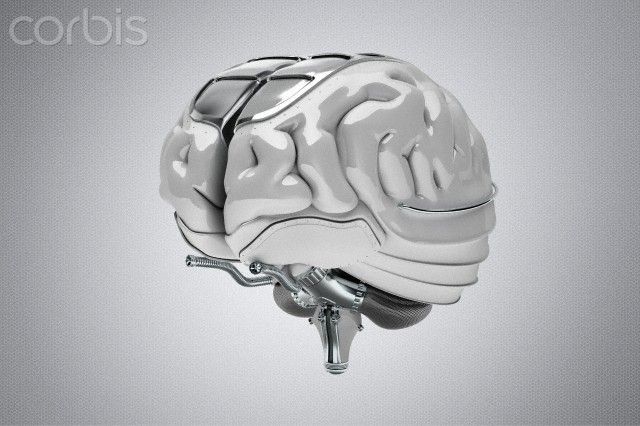 However, government and private industry wouldn’t be motivated by such factors (that is, ability to optimize certain performance measures, or to ascertain liability) in the first place, if they were to attempt something like this – since they wouldn’t be selling it. The only reason I foresee government or industry being interested in attempting this is if a foreign nation or competitor, respectively, initiated such a project, in which case they might attempt it simply to stay competitive in the case of industry and on equal militaristic defensive/offensive footing in the case of government. But the fact that optimization-of-performance-measures and clear liabilities don’t apply to Blind Replication means that a wealthy individual would be more likely to attempt this, because government and industry have much more to lose in terms of liability, were someone to find out.
However, government and private industry wouldn’t be motivated by such factors (that is, ability to optimize certain performance measures, or to ascertain liability) in the first place, if they were to attempt something like this – since they wouldn’t be selling it. The only reason I foresee government or industry being interested in attempting this is if a foreign nation or competitor, respectively, initiated such a project, in which case they might attempt it simply to stay competitive in the case of industry and on equal militaristic defensive/offensive footing in the case of government. But the fact that optimization-of-performance-measures and clear liabilities don’t apply to Blind Replication means that a wealthy individual would be more likely to attempt this, because government and industry have much more to lose in terms of liability, were someone to find out.
Could Upload+AGI be easier to implement than AGI alone?
This means that the creation of an intelligence with a subjective perception of time significantly greater than unmodified humans (what might be called Ultra-Fast Intelligence) may be more likely to occur via an upload, rather than an AGI, because the creation of an AGI is largely determined by increases in both computational processing and software performance/capability, whereas the creation of an upload may be determined by-and-large by processing-power and thus remain largely independent of the need for significant improvements in software performance or “methodological implementation”
If the premise that such an upload could significantly accelerate a coming intelligence explosion (whether by using his/her comparative advantages to recursively self-modify his/herself, to accelerate innovation and R&D in computational hardware and/or software, or to create a recursively-self-improving AGI) is taken as true, it follows that even the coming of an AGI-mediated intelligence explosion specifically, despite being impacted by software improvements as well as computational processing power, may be more impacted by basic processing power (e.g. IPS) than by computational price performance — and may be more determined by computational processing power than by processing power + software improvements. This is only because uploading is likely to be largely independent of increases in software (i.e. methodological as opposed to technological) performance. Moreover, development in AGI may proceed faster via the vicarious method outlined here – namely having an upload or team of uploads work on the software and/or hardware improvements that AGI relies on – than by directly working on such improvements in “real-time” physicality.
Virtual Advantage:
 The increase in subjective perception of time alone (if Yudkowsky’s estimate is correct, a ratio of 250 subjective years for every “real-time” hour) gives him/her a massive advantage. It also would likely allow them to counter-act and negate any attempts made from “real-time” physicality to stop, slow or otherwise deter them.
The increase in subjective perception of time alone (if Yudkowsky’s estimate is correct, a ratio of 250 subjective years for every “real-time” hour) gives him/her a massive advantage. It also would likely allow them to counter-act and negate any attempts made from “real-time” physicality to stop, slow or otherwise deter them.
There is another feature of virtual embodiment that could increase the upload’s ability to accelerate such developments. Neural modification, with which he could optimize his current functional modalities (e.g. what we coarsely call “intelligence”) or increase the metrics underlying them, thus amplifying his existing skills and cognitive faculties (as in Intelligence Amplification or IA), as well as creating categorically new functional modalities, is much easier from within virtual embodiment than it would be in physicality. In virtual embodiment, all such modifications become a methodological, rather than technological, problem. To enact such changes in a physically-embodied nervous system would require designing a system to implement those changes, and actually implementing them according to plan. To enact such changes in a virtually-embodied nervous system requires only a re-organization or re-writing of information. Moreover, in virtual embodiment, any changes could be made, and reversed, whereas in physical embodiment reversing such changes would require, again, designing a method and system of implementing such “reversal-changes” in physicality (thereby necessitating a whole host of other technologies and methodologies) – and if those changes made further unexpected changes, and we can’t easily reverse them, then we may create an infinite regress of changes, wherein changes made to reverse a given modification in turn creates more changes, that in turn need to be reversed, ad infinitum.
Thus self-modification (and especially recursive self-modification), towards the purpose of intelligence amplification into Ultraintelligence [7] in easier (i.e. necessitating a smaller technological and methodological infrastructure – that is, the required host of methods and technologies needed by something – and thus less cost as well) in virtual embodiment than in physical embodiment.
These recursive modifications not only further maximize the upload’s ability to think of ways to accelerate the coming of an intelligence explosion, but also maximize his ability to further self-modify towards that very objective (thus creating the positive feedback loop critical for I.J Good’s intelligence explosion hypothesis) – or in other words maximize his ability to maximize his general ability in anything.
But to what extent is the ability to self-modify hampered by the critical feature of Blind Replication mentioned above – namely, the inability to modify and optimize various performance measures by virtue of the fact that we can’t predictively model the operational dynamics of the system-in-question? Well, an upload could copy himself, enact any modifications, and see the results – or indeed, make a copy to perform this change-and-check procedure. If the inability to predictively model a system made through the “Blind Replication” method does indeed problematize the upload’s ability to self-modify, it would still be much easier to work towards being able to predictively model it, via this iterative change-and-check method, due to both the subjective-perception-of-time speedup and the ability to make copies of himself.
It is worth noting that it might be possible to predictively model (and thus make reliable or stable changes to) the operation of neurons, without being able to model how this scales up to the operational dynamics of the higher-level neural regions. Thus modifying, increasing or optimizing existing functional modalities (i.e. increasing synaptic density in neurons, or increasing the range of usable neurotransmitters — thus increasing the potential information density in a given signal or synaptic-transmission) may be significantly easier than creating categorically new functional modalities.
Increasing the Imminence of an Intelligent Explosion:
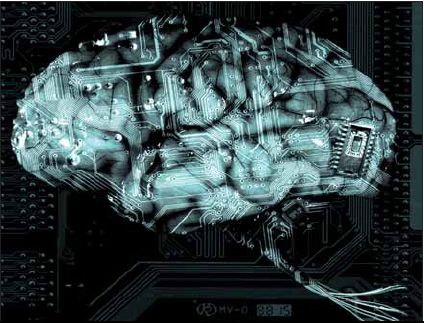 So what ways could the upload use his/her new advantages and abilities to actually accelerate the coming of an intelligence explosion? He could apply his abilities to self-modification, or to the creation of a Seed-AI (or more technically a recursively self-modifying AI).
So what ways could the upload use his/her new advantages and abilities to actually accelerate the coming of an intelligence explosion? He could apply his abilities to self-modification, or to the creation of a Seed-AI (or more technically a recursively self-modifying AI).
He could also accelerate its imminence vicariously by working on accelerating the foundational technologies and methodologies (or in other words the technological and methodological infrastructure of an intelligence explosion) that largely determine its imminence. He could apply his new abilities and advantages to designing better computational paradigms, new methodologies within existing paradigms (e.g. non-Von-Neumann architectures still within the paradigm of electrical computation), or to differential technological development in “real-time” physicality towards such aims – e.g. finding an innovative means of allocating assets and resources (i.e. capital) to R&D for new computational paradigms, or optimizing current computational paradigms.
Thus there are numerous methods of indirectly increasing the imminence (or the likelihood of imminence within a certain time-range, which is a measure with less ambiguity) of a coming intelligence explosion – and many new ones no doubt that will be realized only once such an upload acquires such advantages and abilities.
Intimations of Implications:
So… Is this good news or bad news? Like much else in this increasingly future-dominated age, the consequences of this scenario remain morally ambiguous. It could be both bad and good news. But the answer to this question is independent of the premises – that is, two can agree on the viability of the premises and reasoning of the scenario, while drawing opposite conclusions in terms of whether it is good or bad news.
 People who subscribe to the “Friendly AI” camp of AI-related existential risk will be at once hopeful and dismayed. While it might increase their ability to create their AGI (or more technically their Coherent-Extrapolated-Volition Engine [8]), thus decreasing the chances of an “unfriendly” AI being created in the interim, they will also be dismayed by the fact that it may include (but not necessitate) a recursively-modifying intelligence, in this case an upload, to be created prior to the creation of their own AGI – which is the very problem they are trying to mitigate in the first place.
People who subscribe to the “Friendly AI” camp of AI-related existential risk will be at once hopeful and dismayed. While it might increase their ability to create their AGI (or more technically their Coherent-Extrapolated-Volition Engine [8]), thus decreasing the chances of an “unfriendly” AI being created in the interim, they will also be dismayed by the fact that it may include (but not necessitate) a recursively-modifying intelligence, in this case an upload, to be created prior to the creation of their own AGI – which is the very problem they are trying to mitigate in the first place.
Those who, like me, see a distributed intelligence explosion (in which all intelligences are allowed to recursively self-modify at the same rate – thus preserving “power” equality, or at least mitigating “power” disparity [where power is defined as the capacity to affect change in the world or society] – and in which any intelligence increasing their capably at a faster rate than all others is disallowed) as a better method of mitigating the existential risk entailed by an intelligence explosion will also be dismayed. This scenario would allow one single person to essentially have the power to determine the fate of humanity – due to his massively increased “capability” or “power” – which is the very feature (capability disparity/inequality) that the “distributed intelligence explosion” camp of AI-related existential risk seeks to minimize.
On the other hand, those who see great potential in an intelligence explosion to help mitigate existing problems afflicting humanity – e.g. death, disease, societal instability, etc. – will be hopeful because the scenario could decrease the time it takes to implement an intelligence explosion.
I for one think that it is highly likely that the advantages proffered by accelerating the coming of an intelligence explosion fail to supersede the disadvantages incurred by the increase existential risk it would entail. That is, I think that the increase in existential risk brought about by putting so much “power” or “capability-to-affect-change” in the (hands?) one intelligence outweighs the decrease in existential risk brought about by the accelerated creation of an Existential-Risk-Mitigating A(G)I.
Conclusion:
Thus, the scenario presented above yields some interesting and counter-intuitive conclusions:
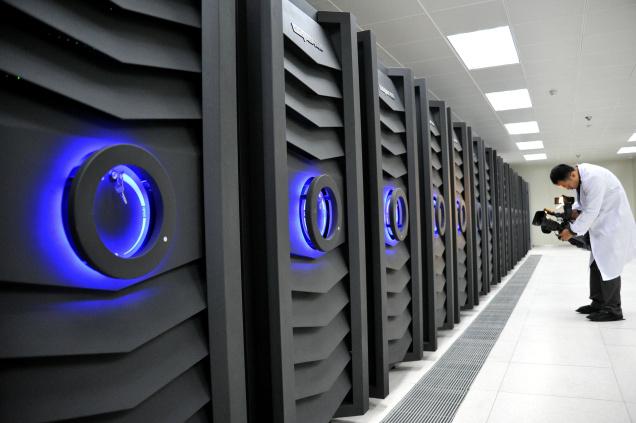 How imminent an intelligence explosion is, or how likely it is to occur within a given time-frame, may be more determined by basic processing power than by computational price performance, which is a measure of basic processing power per unit of cost. This is because as soon as we have enough processing power to emulate a human nervous system, provided we have sufficient software to emulate the lower level neural components giving rise to the higher-level human mind, then the increase in the rate of thought and subjective perception of time made available to that emulation could very well allow it to design and implement an AGI before computational price performance increases by a large enough factor to make the processing power necessary for that AGI’s implementation available for a widely-affordable cost. This conclusion is independent of any specific estimates of how long the successful computational emulation of a human nervous system will take to achieve. It relies solely on the premise that the successful computational emulation of the human mind can be achieved faster than the successful implementation of an AGI whose design is not based upon the cognitive architecture of the human nervous system. I have outlined various reasons why we might expect this to be the case. This would be true even if uploading could only be achieved faster than AGI (given an equal amount of funding or “effort”) by a seemingly-negligible amount of time, like one week, due to the massive increase in speed of thought and the rate of subjective perception of time that would then be available to such an upload.
How imminent an intelligence explosion is, or how likely it is to occur within a given time-frame, may be more determined by basic processing power than by computational price performance, which is a measure of basic processing power per unit of cost. This is because as soon as we have enough processing power to emulate a human nervous system, provided we have sufficient software to emulate the lower level neural components giving rise to the higher-level human mind, then the increase in the rate of thought and subjective perception of time made available to that emulation could very well allow it to design and implement an AGI before computational price performance increases by a large enough factor to make the processing power necessary for that AGI’s implementation available for a widely-affordable cost. This conclusion is independent of any specific estimates of how long the successful computational emulation of a human nervous system will take to achieve. It relies solely on the premise that the successful computational emulation of the human mind can be achieved faster than the successful implementation of an AGI whose design is not based upon the cognitive architecture of the human nervous system. I have outlined various reasons why we might expect this to be the case. This would be true even if uploading could only be achieved faster than AGI (given an equal amount of funding or “effort”) by a seemingly-negligible amount of time, like one week, due to the massive increase in speed of thought and the rate of subjective perception of time that would then be available to such an upload.- The creation of an upload may be relatively independent of software performance/capability (which is not to say that we don’t need any software, because we do, but rather that we don’t need significant increases in software performance or improvements in methodological implementation – i.e. how we actually design a mind, rather than the substrate it is instantiated by – which we do need in order to implement an AGI and which we would need for WBE, were the system we seek to emulate not already in existence) and may in fact be largely determined by processing power or computational performance/capability alone, whereas AGI is dependent on increases in both computational performance and software performance or fundamental progress in methodological implementation.
- If this second conclusion is true, it means that an upload may be possible quite soon considering the fact that we’ve passed the basic estimates for processing requirements given by Kurzweil, Moravec and Storrs-Hall, provided we can emulate the low-level neural regions of the brain with high predictive accuracy (and provided the claim that instantiating such low-level components will vicariously instantiate the emergent human mind, without out needing to really understand how such components functionally-converge to do so, proves true), whereas AGI may still have to wait for fundamental improvements to methodological implementation or “software performance”
- Thus it may be easier to create an AGI by first creating an upload to accelerate the development of that AGI’s creation, than it would be to work on the development of an AGI directly. Upload+AGI may actually be easier to implement than AGI alone is!
References:
[1] Kurzweil, R, 2005. The Singularity is Near. Penguin Books.
[2] Moravec, H, 1997. When will computer hardware match the human brain?. Journal of Evolution and Technology, [Online]. 1(1). Available at: http://www.jetpress.org/volume1/moravec.htm [Accessed 01 March 2013].
[3] Hall, J (2006) “Runaway Artificial Intelligence?” Available at: http://www.kurzweilai.net/runaway-artificial-intelligence [Accessed: 01 March 2013]
[4] Adam Ford. (2011). Yudkowsky vs Hanson on the Intelligence Explosion — Jane Street Debate 2011 . [Online Video]. August 10, 2011. Available at: https://www.youtube.com/watch?v=m_R5Z4_khNw [Accessed: 01 March 2013].
[5] Drexler, K.E, (1989). MOLECULAR MANIPULATION and MOLECULAR COMPUTATION. In NanoCon Northwest regional nanotechnology conference. Seattle, Washington, February 14–17. NANOCON. 2. http://www.halcyon.com/nanojbl/NanoConProc/nanocon2.html [Accessed 01 March 2013]
[6] Sandberg, A. & Bostrom, N. (2008). Whole Brain Emulation: A Roadmap, Technical Report #2008–3. http://www.philosophy.ox.ac.uk/__data/assets/pdf_file/0019/3…report.pdf [Accessed 01 March 2013]
[7] Good, I.J. (1965). Speculations Concerning the First Ultraintelligent Machine. Advances in Computers.
[8] Yudkowsky, E. (2004). Coherent Extrapolated Volition. The Singularity Institute.
]]>
Emotions and Longevity:
If the picture header above influenced you to click to read more of this article, then it establishes at least part of my hypothesis: Visual stimuli that trigger our primal urges, supersede all our senses, even over-riding intellect. By that I mean, irrespective of IQ level, the visual alone and not the title of the essay will have prompted a click through –Classic advertising tactic: Sex sells.
Yet, could there be a clue in this behavior to study further, in our quest for Longevity? Before Transhumanism life extension technology such as nano-tech and bio-tech go mainstream… we need to keep our un-amped bodies in a state of constant excitement, using visual triggers that generate positive emotions, thereby hopefully, keeping us around long enough to take advantage of these bio-hacks when they become available.
Emotions on Demand — The “TiVo-ing” of feelings:
From the graphic above, it is easy to extrapolate that ‘positive’ emotions can contribute significantly to Longevity. When we go on a vacation, we’re experiencing the world in a relaxed frame of mind and encoding these experiences, even if sub-consciously, in our brains (minds?). Days, or even years later we can call on these experiences, on-demand, to bring us comfort.
Granted, much like analog recordings… over time, these stored copies of positive emotions will deteriorate, and just as we can today digitize images and sounds, making for pristine everlasting copies… can we digitize Emotions for recall and to experience them on-demand?
How would we go about doing it and what purpose does it serve?
Digitizing Touch: Your Dirrogate’s unique Emotional Signature:
Can we digitize Touch; a crucial building block that contributes to the creation of Emotions? For an answer, we need to look to the (and to some, the questionable) technology behind Teledildonics.
While the tech to experience haptic feed-back has been around for a while, it’s been mostly confined to Virtual Reality simulations and for training purposes. Crude haptic-force feedback gaming controllers are available on the market, but advances in actuators, and nano-scale miniaturization are soon to change that, even going as far as to give us tactile imaging capability — “Smart Skin”
Recently, Durex announced “Fundawear”. It’s purpose? To experience the “touch” of your partner in a fun light-hearted way. Yet, what if a Fundawear session could be recorded and played back later? The unique way your partner touches, forever digitized for playback when desired… allowing you to experience the emotion of joy and happiness at will?
Fundawear can be thought of as a beta v1.0 of something akin to smart-skin in reverse, which could eventually allow a complete “feel-stream” to be digitized and played back on-demand.
Currently we are already able to digitize some faculties that stimulate two of our primary senses:
- Sight — via a video camera.
- Sound — via microphones.
So how do we go about digitizing and re-creating the sense of Touch?
Solutions such as the one from NuiCapture shown in the video above, in combination with off the shelf game hardware such as the Kinect, can Digitize a whole body “performance” — Also known as performance capture.
Dirrogates and 3D Printing a Person:
In the near future if we get blue-prints to 3D print a person, ready for re-animation and complete with “smart-skin”… such a 3D printed surrogate could reciprocate our touch.
It would be an exercise in imagination, to envision 3D printing your partner, if they couldn’t be with you when you wanted them, or indeed it could raise moral and ethical issues such as ‘adultery’ if an un-authorized 3D printed copy was produced of a person, and their “signature” performance files was pirated.
But with every evil, there is also the good. 3D printers can print guns, or as seen in the video above: a prosthetic hand, allowing a child to experience life the way other children do — That is the ethos of Transhumanism.
Loneliness can kill you:
Well maybe not exactly kill you, but it can negatively impact your health, says The World of Psychology. That would be counterproductive in our quest for Longevity.
A few years ago, companies such as Accenture introduced family collaboration projects. I recommend clicking on the link to read the article, as copyright restrictions prevent including it in this essay. In essence, it allows older relatives to derive emotional comfort from seeing and interacting with their families living miles away.
At a very basic level, we are already Transhuman. No stigma involved… no religious boundaries crossed. This ethical use of technology, can bring comfort to an aging section of society, bettering their condition.
In a relationship, the loss of a loved one can be devastating to the surviving partner, even more so, if the couple had grown old together and shared their good and bad times. Experiencing and re-living memories that transcend photographs and videos, could contribute towards generating positive emotions and thus longevity in the person coping with his/her loss.
While 3D printing and re-animating a person is still a few years away, there is another stop-gap technology: Augmented Reality. With AR visors, we can see and interact with a “Dirrogate” (Digital Surrogate) of another person as though they were in the same room with us. The person’s Dirrogate can be operated in real-time by another person living thousands of miles away… or a digitized touch stream can be called on… long after the human operator is no more.
In the story: “Memories with Maya”, the context and it’s repercussion on our evolution into a Transhuman species, is explored in more detail.
The purpose of this essay is to seed ideas only, and is not to be taken as expert advice.
]]>
There is a real power in the act of physically moving. In so doing, each and every morning I can escape the cacophonous curse of the ubiquitous ESPN in the gym locker room. I toss my bag in my locker and immediately escape to the pure, perfect, custom designed peace of my iPod’s audio world. I also well remember the glorious day I moved away from the hopelessness of my roommate’s awful sub-human, sub-slum stench and into my own private apartment. The universe changed miraculously overnight. I think you can get my drift. The simple act of moving itself can be powerfully transformational. Sometimes, there is not enough bleach and not enough distance between the walls to have the desired effect. Physically moving is quite often the only answer.
As we consider transhumanist societies, such transitional power is certainly the result by many magnitudes. My team has been engaged in developing the first permanent human undersea settlement over the past few decades. In this process we have had the distinct advantage of planning profoundly transhumanist advances specifically because of the advantageous context of relative community isolation. Further we have the benefit of deriving change as a community necessity — as a psychological and cultural imperative for this degree of advanced cultural evolution. It is a real kind of powerfully driven societal punctuated equilibrium that can be realized in few other ways.
In moving into the oceans, the submarine environment itself immediately establishes the boundary between the new, evolving culture and the old. While the effect and actual meaning of this boundary is almost always overrated, it is nonetheless a real boundary layer that allows the new culture to flourish sans the interferences or contamination from the old. Trying to accomplish transhumanist goals while culturally embedded is far more difficult and far less persuasive to those who must undergo dramatic change and for the transformation to actually take hold and survive generationally. But in a new, rather isolated environment, the pressure to evolve and integrate permanent change is not only easier, it is rather expected as a part of the reasonable process of establishment.
In one of our most powerful spin-offs back to the land-dwellers (LDs), our culture will begin on day one as a ‘waste-free culture’. It is an imperative and therefore a technological design feature. It is a value system. It is codified. It is a defining element of our new culture. It is also radically transhumanist. In our society, we teach this to one another and to our children, as well as every subsequent generation. In our undersea culture we have a process called ‘resource recovery’, since every product of every process is a resource to be utilized in the next round of community life cycle processing. Hence even the vilest sewage is just a part of the carbon cycle for the next round of our life support system engineering. Nothing is to be ‘wasted’. Nothing is to be ‘cast off’. We cannot afford ‘waste’ of any kind, hence waste will cease to exist as a concept. Everything is a resource. The life of the next cycle depends on the successful re-integration of each preceding cycle. The future life and wellbeing of the colony directly depends on the successful implementation of the conservation of resources and in turn the preservation of the natural health of its immediate environment in just this fashion.
Such advancement would be most difficult to engineer in a land-dweller community. The first problem would be simple re-education and the most elementary expectations. The next hurdle would be the re-engineering of every process that the LDs now identify as ‘waste processing’, ‘waste storage’, ‘waste distribution’ etc. Sadly, much of the LD’s unprocessed and unstabilized product is dumped into our ocean environment! But in the simple act of moving the same people to a new social structure, the impossible becomes surprisingly straightforward and even easy to implement. The difference and the power were always implicit in the move itself. The transhumanist ideal seems much better framed in this context when one considers that this is only one of countless examples of building new societies that are cleanly separated from the old.
It is certain to engender arguments to the contrary, I am sure. For how often is the rare opportunity available to move into a new cultural paradigm cleanly distinct from its predecessor? Certainly then the transhumanist concept must be able to rely on in situ prototypes that must be ultimately successful for the successful evolution of the culture. I have no argument with this, except to emphasize the intrinsic power in clean cultural separation as described in this example.
Obviously the ocean settlement is only one prototype. Space settlements and surface based seasteading are other examples to consider. The fact is clear, transhumanist cultures will always and quite easily develop in the new isolated human communities that are about to flourish in the most unexpected of places.
_________________________________________
Dennis Chamberland is the Expeditions Leader for the Atlantica Expeditions, where others may participate. Dennis is also a writer, the author of the book, Undersea Colonies and others, where many of these concepts are discussed in greater detail.

Transhumanism is all about the creative and ethical use of technology to better the human condition. Futurists, when discussing topics related to transhumanism, tend to look at nano-tech, bio-mechanical augmentation and related technology that, for the most part, is beyond the comprehension of lay-people.
If Transhumanism as a movement is to succeed, we have to explain it’s goals and benefits to humanity by addressing the common-man. After all, transhumanism is not the exclusive domain, nor restricted to the literati, academia or the rich. The more the common man realizes that (s)he is indeed already transhuman in a way — the lesser the taboo associated with the movement and the faster the law of accelerating returns will kick in, leading to eventual Tech Singularity.
Augmented Reality Visors: Enabling Transhumanism.
At the moment, Google Glass is not exactly within reach of the common man, even if he want’s to pay for it. It is “invite only”, which may be counter productive to furthering the Transhumanism cause. Now, to be fair, it may be because the device is still in beta testing, and once any bugs have been ironed out, the general public will benefit from both, a price drop and accessibility, because if Google does not do it, China will.
Google Glass: A Transhumanist’s Swiss Knife
Glass is the very definition of an augmented human, at least until the time hi-tech replaceable eye-balls, or non-obtrusive human augmentation technology becomes common-place. Glass is a good attempt at a wearable computing device that is practical. While it does lend a cyborg look to it’s wearer, future iterations will no doubt, bring the “Matrix” look back into vogue.
Above: Companies such as Vuzix, already have advanced AR capable visors that are aesthetically pleasing to look at and wear. So how is Google Glass (and similar AR visors) the Swiss Army Knife of Transhumanists?
Augmented Human Memory:
Wearing glass, allows a Transhuman to offload his/her memory to glass storage. Everyday examples follow…
- Park your car in a multi-story parking lot, step back a few steps and blink your eyes once. Instant photographic memory of the location via Glass’s wink activated snapshot feature.
- Visited a place once and don’t remember? Call on your “expanded” memory to playback a video recording of the path taken, or display a GPS powered visual overlay in your field of view.
Previously, this was done via a cellphone. In both cases, one is already Transhuman. This is what the common man needs to be made aware of and there will be less of a stigma attached to: The World’s most dangerous idea.
Life Saver — “Glass Angel”
Every one is said to have a “Guardian Angel” watching over them, yet an app named “Glass Angel” would be an apt name for a collection of potentially life saving modules that could run on Google Glass.
- CPR Assist: How many people can honestly say they know CPR? or even the Heimlich maneuver? Crucial moments can be saved when access to such knowledge is available… while freeing up our hands to assist the person in distress. In future iterations of Google glass (glass v2.0?) if true augmented reality capability is provided, a CGI human skeleton can be overlaid on the live patient, giving visual cues to further assist in such kinds of situations.
- Driver Safety: There are some states in the US looking at banning the use of Google Glass while driving. Yet, it is interesting to note that Glass could be that Guardian Angel watching over a driver who might nod off at the wheel after a long day at work. (DUI is not an excuse however to use Glass). The various sensors can monitor for tilt of head and sound an alarm, or even recognize unusual behavior of the wearer by analyzing and tracking the live video feed coming in through the camera…sounding an alarm to warn the wearer.
Augmented Intelligence — or — Amplified Intelligence:
How many times a day do we rely on auto-spell or Google’s auto correct to pop up and say “Did you mean” to warn us of spelling errors or even context errors? How many times have we blindly trusted Google to go ahead and auto-correct for us? While it can be argued that dependence on technology is actually dulling our brains, it is an un-arguable fact that over the coming years, grammar, multi-lingual communication, and more advanced forms of intelligence augmentation will make technology such as Google Glass and it’s successors, indispensable.
Possibly, the Singularity is not all that far away… If the Singularity is the point when Technology overtakes human intelligence… I see it as the point when human intelligence regresses to meet technology, mid-way.
On a more serious note: Should we be alarmed at our increasing dependence on Augmented Intelligence? or should we think of it as simply a storage and retrieval system.
If a lecturer on-stage, addressing a gathering of intellectuals, uses his eyeballs to scroll up a list of synonyms in real time on his Google glass display, to use a more succinct word or phrase when making a point, does that make him sound more intelligent?… how about if he punctuates the point by calling up the german translation of the phrase?
These are questions that I leave open to you…
Digital Bread Crumbs- Quantum Archeology and Immortality.
Every time we share a photo, a thought… an emotion as a status update: we are converting a biological function into a digital one. We are digitizing our analog stream-of-consciousness.
These Digital Breadcrumbs that we leave behind, will be mined by “deep learning” algorithms, feeding necessary data that will drive Quantum Archeology processes… that may one day soon, resurrect us — Digital Resurrection. This might sound like a Transhumanist’s Hansel and Gretel fairy-tale… but not for long.
How does Google Glass fit in? It’s the device that will accelerate the creation of Digital Bread-crumbs. I’d saved this most radical idea for last: Digital Resurrection.
Glass is already generating these BreadCrumbs — transhumanizing the first round of beta testers wearing the device.
The next version of Google Glass, if it features true see-through Augmented Reality support, or indeed a visor from a Google competitor, will allow us to see and interact with these Digital Surrogates of immortal beings. It’s described with plausible hard science to back it up, in Chapter 6 of Memories with Maya — The Dirrogate.
I’d like to end this essay by opening it up to wiki like input from you. What ideas can you come up with to make Google Glass a swiss army knife for Transhumanists?
(This article was originally posted on the Science behind the story section on Dirrogate.com)
]]>
Immortal Life is presenting a public event in Washington D.C., titled “Radical Life Extension: are you ready to live 1,000 years?”
It will take place in the historic Friends Meeting House on September 22 (Sunday). The event will be from 5:30–7:30.
We will have 10–12 speakers discussing Immortality / Life Extension from a wide variety of perspectives: scientific, political, social, poetic, religious, atheistic, economic, demographic, moral, etc.
Our lineup of speakers even features numerous Lifeboat Foundation Advisors , including myself, Gabriel Rothblatt, Hank Pellissier, Antonei B. Csoka, and Didier Coeurnelle. Other speakers include Mark Waser, Gray Scott, Jennifer ‘Dotora’ Huse, Apneet Jolly, Tom Mooney, Hank Fox, Maitreya One Paul Spiegel and Rich Lee.
There are still a few available slots for speakers but they’re filling fast, so if you’re interested in reserving a seat, being a speaking or contributing in any other way, please have them send an email to [email protected]
We have already attained the support of numerous life extension groups in the Washington DC area, but are always grateful for funding contributions from sponsors to help us with travel and advertising costs, and speaker stipends, for this event and future events. Promoters are always welcome as well.
]]>
A widely accepted definition of Transhumanism is: The ethical use of all kinds of technology for the betterment of the human condition.
This all encompassing summation is a good start as an elevator pitch to laypersons, were they to ask for an explanation. Practitioners and contributors to the movement, of course, know how to branch this out into specific streams: science, philosophy, politics and more.
- This article was originally published on ImmortalLife.info
We are in the midst of a technological revolution, and it is cool to proclaim that one is a Transhumanist. Yet, many intelligent and focused Transhumanists are asking some all important questions: What road-map have we drawn out, and what concrete steps are we taking to bring to fruition, the goals of Transhumanism?
Transhumanism could be looked at as culminating in Technological Singularity. People comprehend the meaning of Singularity differently. One such definition: Singularity marks a moment when technology trumps the human brain, and the limitations of the mind are surpassed by artificial intelligence. Being an Author and not a scientist myself, my definition of the Singularity is colored by creative vision. I call it Dirrogate Singularity.
I see us humans, successfully and practically, harnessing the strides we’ve made in semiconductor tech and neural networks, Artificial intelligence, and digital progress in general over the past century, to create Digital Surrogates of ourselves — our Dirrogates. In doing so, humans will reach pseudo-God status and will be free to merge with these creatures they have made in their own likeness…attaining, Dirrogate Singularity.
So, how far into the future will this happen? Not very far. In fact it can commence as soon as today or as far as, in a couple of years. The conditions and timing are right for us to “trans-form” into Digital Beings; Dirrogates.
I’ll use excerpts from the story ‘Memories with Maya’ to seed ideas for a possible road-map to Dirrogate Singularity, while keeping the tenets of Transhumanism in focus on the dashboard as we steer ahead. As this text will deconstruct many parts of the novel, major spoilers are unavoidable.
Dirrogate Singularity v/s The Singularity:
The main distinction in definition I make is: I don’t believe Singularity is the moment when technology trumps the human brain. I believe Singularity is when the human mind accepts and does not discriminate between an advanced “Transhuman” (effectively, a mind upload living in a bio-mechanical body) and a “Natural” (an un-amped homo sapien)
This could be seen as a different interpretation of the commonly accepted concept of The Singularity. As one of the aims of this essay is to create a possible road-map to seed ideas for the Transhumanism movement, I choose to look at a wholly digital path to Transhumanism, bypassing human augmentation via nanotechnology, prosthetics or cyborg-ism. As we will see further down, Dirrogate Singularity could slowly evolve into the common accepted definitions of Technological Singularity.
What is a Dirrogate:
A portmanteau of Digital + Surrogate. An excerpt from the novel explains in more detail:
“Let’s run the beta of our social interaction module outside.”
Krish asked the prof to follow him to the campus ground in front of the food court. They walked out of the building and approached a shaded area with four benches. As they were about to sit, my voice came through the phone’s speaker. “I’m on your far right.”
Krish and the prof turned, scanning through the live camera view of the phone until they saw me waving. The phone’s compass updated me on their orientation. I asked them to come closer.
“You have my full attention,” the prof said. “Explain…”
“So,” Krish said, in true geek style… “Dan knows where we are, because my phone is logged in and registered into the virtual world we have created. We use a digital globe to fly to any location. We do that by using exact latitude and longitude coordinates.” Krish looked at the prof, who nodded. “So this way we can pick any location on Earth to meet at, provided of course, I’m physically present there.”
“I understand,” said the prof. “Otherwise, it would be just a regular online multi-player game world.”
“Precisely,” Krish said. “What’s unique here is a virtual person interacting with a real human in the real world. We’re now on the campus Wifi.” He circled his hand in front of his face as though pointing out to the invisible radio waves. “But it can also use a high-speed cell data network. The phone’s GPS, gyro, and accelerometer updates as we move.”
Krish explained the different sensor data to Professor Kumar. “We can use the phone as a sophisticated joystick to move our avatar in the virtual world that, for this demo, is a complete and accurate scale model of the real campus.”
The prof was paying rapt attention to everything Krish had to say. “I laser scanned the playground and the food-court. The entire campus is a low rez 3D model,” he said. “Dan can see us move around in the virtual world because my position updates. The front camera’s video stream is also mapped to my avatar’s face, so he can see my expressions.”
“Now all we do is not render the virtual buildings, but instead, keep Daniel’s avatar and replace it with the real-world view coming in through the phone’s camera,” explained Krish.
“Hmm… so you also do away with render overhead and possibly conserve battery life?” the prof asked.
“Correct. Using GPS, camera and marker-less tracking algorithms, we can update our position in the virtual world and sync Dan’s avatar with our world.”
“And we haven’t even talked about how AI can enhance this,” I said.
I walked a few steps away from them, counting as I went.
“We can either follow Dan or a few steps more and contact will be broken. This way in a social scenario, virtual people can interact with humans in the real world,” Krish said. I was nearing the personal space out of range warning.
“Wait up, Dan,” Krish called.
I stopped. He and the prof caught up.
“Here’s how we establish contact,” Krish said. He touched my avatar on the screen. I raised my hand in a high-five gesture.
“So only humans can initiate contact with these virtual people?” asked the prof.
“Humans are always in control,” I said. They laughed.
“Aap Kaise ho?” Krish said.
“Main theek hoo,” I answered a couple of seconds later, much to the surprise of the prof.
“The AI module can analyze voice and cross-reference it with a bank of ten languages.” he said. “Translation is done the moment it detects a pause in a sentence. This way multicultural communication is possible. I’m working on some features for the AI module. It will be based on computer vision libraries to study and recognize eyebrows and facial expressions. This data stream will then be accessible to the avatar’s operator to carry out advanced interaction with people in the real world–”
“So people can have digital versions of themselves and do tasks in locations where they cannot be physically present,” the prof completed Krish’s sentence.
“Cannot or choose not to be present and in several locations if needed,” I said. “There is no reason we can’t own several digital versions of ourselves doing tasks simultaneously.”
“Each one licensed with a unique digital fingerprint registered with the government or institutions offering digital surrogate facilities.” Krish said.
“We call them di-rro-gates.” I said.
One of the characters in the story also says: “Humans are creatures of habit.” and, “We live our lives following the same routine day after day. We do the things we do with one primary motivation–comfort.”
Whether this is entirely true or not, there is something to think about here… What does ‘improving the human condition’ imply? To me Comfort, is high on the list and a major motivation. If people can spawn multiple Dirrogates of themselves that can interact with real people wearing future iterations of Google Glass (for lack of a more popular word for Augmented Reality visors)… then the journey on the road-map to Dirrogate Singularity is to see a few case examples of Dirrogate interaction.
Evangelizing Transhumanism:
In writing the novel, I took several risks, story length being one. I’ve attempted to keep the philosophy subtle, almost hidden in the story, and judging by reviews on sites such as GoodReads.com, it is plain to see that many of today’s science fiction readers are after cliff hanger style science fiction and gravitate toward or possibly expect a Dystopian future. This root craving must be addressed in lay people if we are to make Transhumanism as a movement, succeed.
I’d noticed comments made that the sex did not add much to the story. No one (yet) has delved deeper to see if there was a reason for the sex scenes and if there was an underlying message. The success of Transhumanism is going to be in large scale understanding and mass adoption of the values of the movement by laypeople. Google Glass will make a good case study in this regard. If they get it wrong, Glass will quickly share the same fate and ridicule as wearing blue-tooth headsets.
One of the first things, in my view, to improving the human condition, is experiencing pleasure… of every kind, especially carnal.
In that sense, we already are Digital Transhumans. Long distance video calls, teledildonics and recent mainstream offerings such as Durex’s “Fundawear” can bring physical, emotional and psychological comfort to humans, without the traditional need for physical proximity or human touch.
(Durex’s Fundawear – Image Courtesy Snapo.com)
These physical stimulation and pleasure giving devices add a whole new meaning to ‘wearable computing’. Yet, behind every online Avatar, every Dirrogate, is a human operator. Now consider: What if one of these “Fundawear” sessions were recorded?
The data stream for each actuator in the garment, stored in a file – a feel-stream, unique to the person who created it? We could then replay this and experience or reminisce the signature touch of a loved one at any time…even long after they are gone; are no more. Would such as situation qualify as a partial or crude “Mind upload”?
Mind Uploading – A practical approach.
Using Augmented Reality hardware, a person can see and experience interaction with a Dirrogate, irrespective if the Dirrogate is remotely operated by a human, or driven by prerecorded subroutines under playback control of an AI. Mind uploading [at this stage of our technological evolution] does not have to be a full blown simulation of the mind.
Consider the case of a Google Car. Could it be feasible that a human operator remotely ‘drive’ the car with visual feedback from the car’s on-board environment analysis cameras? Any AI in the car could be used on an as-needed basis. Now this might not be the aim of a driver-less car, and why would you need your Dirrogate to physically drive when in essence you could tele-travel to any location?
Human Shape Shifters:
Reasons could be as simple as needing to transport physical cargo to places where home delivery is not offered. Your Dirrogate could drive the car. Once at the location [hardware depot], your Dirrogate could merge with the on-board computer of an articulated motorized shopping cart. Check out counter staff sees your Dirrogate augmented in the real world via their visor. You then steer the cart to the parking lot, load in cargo [via the cart’s articulated arm or a helper] and drive home. In such a scenario, a mind upload has swapped physical “bodies” as needed, to complete a task.
If that use made your eyes roll…here’s a real life example:
Devon Carrow, a 2nd grader has a life threatening illness that keeps him away from school. He sends his “avatar” a robot called Vigo.
In the case of a Dirrogate, if the classroom teacher wore an AR visor, she could “see” Devon’s Dirrogate sitting at his desk. A mechanical robot body would be optional. An overhead camera could project the entire Augmented classroom so all children could be aware of his presence. As AR eye-wear becomes more affordable, individual students could interact with Dirrogates. Such use of Dirrogates do fit in completely with the betterment-of-the-human-condition argument, especially if the Dirrogate operator is a human who could come into harm’s way in the real world.
While we simultaneously work on longevity and eliminating deadly diseases, both noble causes, we have to come to terms with the fact that biology has one up on us in the virus department as of today. Epidemic outbreaks such as SARS can keep schools closed. Would it not make sense to maintain the communal ethos of school attendance and classroom interaction by transhumanizing ourselves…digitally?
Does the above example qualify as Mind Uploading? Not in the traditional definition of the term. But looking at it from a different perspective, the 2nd grader has uploaded his mind to a robot.
Dirrogate Immortality via Quantum Archeology:
Below is a passage from the story. The literal significance of which, casual readers of science fiction miss out on:
“Look at her,” I said. “I don’t want her to be a just a memory. I want to keep her memory alive. That day, the Wizer was part of the reason for three deaths. Today, it’s keeping me from dying inside.”
“Help me, Krish,” I said. “Help me keep her memory alive.” He was listening. He wiped his eyes with his hands. I took the Wizer off. “Put it back on,” he said.
A closer look at the Wizer – [visor with Augmented Intelligence built in.]
The preceding excerpt from the story talks about resurrecting her; digital-cryonics.
So, how would Quantum Archeology techniques be applied to resurrect a dead person? Every day we spend hours uploading our stream-of-consciousness to the “cloud”. Photos, videos, Instagrams, Facebook status updates, tweets. All of this is data that can be and is being mined by Deep Learning systems. There’s no prize for guessing who the biggest investor and investigator of Deep Learning is.
Quantum Archeology gets a helping hand with all the digital breadcrumbs we’re leaving around us in this century. The question is: Is that enough information for us to Create a Mind?
Mind Uploading – Libraries and Subroutines:
A more relevant question to ask is, should we attempt to build a mind from the ground up, or start by collecting subroutines and libraries unique to a particular person? Earlier on in the article, it was suggested that by recording a ‘Fundawear’ session, we could re-experience someone’s signature intimate touch. Using Deep Learning, can personality libraries be built?
A related question to answer is: Wouldn’t it make everything ‘artificial’ and be a degraded version of the original? To attempt to answer such a question, let’s look around us today. Aren’t we already degrading our sense of hearing for instance, when we listen to hour after hour of MP3 music sampled at 128kHz or less? How about every time we’ve come to rely on Google’s “did you mean” or Microsoft’s red squiggly line to correct even our simple spellings?
Now, it gets interesting… since we have mind upload “libraries”, we are at liberty to borrow subroutines from more accomplished humans, to augment our own intelligence.
Will the near future allow us to choose a Dirrogate partner with the creative thinking of one person’s personality upload, the intimate skill-set of another and… you get the picture. Most people lead routine 9 to 5 lives. That does not mean that they are not missed by loved ones after they have completed their biological life-cycle. Resurrecting or simulating such minds is much easier than say re-animating Einstein.
In the story, Krish, on digitally resurrecting his father recounts:
“After I saw Maya, I had to,” he said. “I’ve used her same frame structure for the newspaper reading. Last night I went through old photos, his things, his books,” his voice was low. “I’m feeding them into the frame. This was his life for the past two years before the cancer claimed him. Every evening he would sit in this chair in the old house and read his paper.”
I listened in silence as he spoke. Tactile receptors weren’t needed to experience pain. Tone of voice transported those spores just as easily.
“It was easy to create a frame for him, Dan,” he said. “In the time that the cancer was eating away at him, the day’s routine became more predictable. At first he would still go to work, then come home and spend time with us. Then he couldn’t go anymore and he was at home all day. I knew his routine so well it took me 15 minutes to feed it in. There was no need for any random branches.”
I turned to look at him. The Wizer hid his eyes well. “Krish,” I said. “You know what the best part about having him back is? It does not have to be the way it was. You can re-define his routine. Ask your mom what made your dad happy and feed that in. Build on old memories, build new ones and feed those in. You’re the AI designer… bend the rules.”
“I dare not show her anything like this,” he said. “She would never understand. There’s something not right about resurrecting the dead. There’s a reason why people say rest in peace.”
Who is the real Transhuman?
Is it a person who has augmented their physical self or augmented one of their five primary senses? Or is it a human who has successfully re-wired their brain and their mind to accept another augmented human and the tenets of Transhumanism?
“He said perception is in the eye of the beholder… or something to that effect.”
“Maybe he said realism?” I offered.
“Yeah. Maybe. Turns out he is a believer and subscribes to the concept of transhumanism,” Krish said, adjusting the Wizer on the bridge of his nose. “He believes the catalyst for widespread acceptance of transhumanism has to be based on visual fidelity or the entire construct will be stymied by the human brain and mind.”
“Hmm… the uncanny valley effect? It has to be love at first sight, if we are to accept an augmented person huh.”
“Didn’t know you followed the movement,” he said.
“Look around us. Am I really here in person?”
“Point taken,” he said.
While taking the noble cause of Transhumanism forward, we have to address one truism that was put forward in the movie, The Terminator: “It’s in your nature to destroy yourselves.”
When we eventually reach a full mind-upload stage and have the ability to swap or borrow libraries from other ‘minds’, will personality traits of greed still be floating around as rogue libraries? Perhaps the common man is right – A Dystopian future is on the cards, that’s why science fiction writers gravitate toward dystopia worlds.
Could this change as we progress from transhuman to post-human?
In building a road-map for Transhumanism, we need to present and evangelize more to the common man in language and scenarios they can identify with. That is one of the main reasons Memories with Maya features settings and language that at times, borders on juvenile fiction. Concepts such as life extension, reversal of aging and immortality can be made to resound better with laypeople when presented in the right context. There is a reason that Vampire stories are on the nation’s best seller lists.
People are intrigued and interested in immortality.
Memories with Maya – The Dirrogate on Amazon: http://www.amazon.com/Memories-With-Maya-Clyde-Dsouza/dp/148…atfound-20
For more on the science used in the book, visit: Http://www.dirrogate.com
]]>

Of the two images above, as a typical Science Fiction reader, which would you gravitate towards? In designing the cover for my book I ran about 80 iterations of 14 unique designs through a group of beta readers, and the majority chose the one with the Green tint. (design credit: Dmggzz)
No one could come up with a satisfying reason on why they preferred it over the other, except that it “looked more sci-fi” I settled for the design on the right, though it was a very hard decision to make. I was throwing away one of the biggest draws to a book — An inviting Dystopian book cover.
As an Author (and not a scientist) myself, I’ve noticed that scifi readers seem to want dystopian fiction –exclusively. A quick glance at reader preferences in scifi on sites such as GoodReads shows this. Yet, from noticing Vampire themed fiction rule the best seller lists, and from box office blockbusters, we can assume, the common man and woman is also intrigued by Longevity and Immortality.
Why is it so hard for sci-fi fans to look to the “brighter side” of science. Look at the latest Star Trek for instance…Dystopia. Not the feel good, curiosity nurturing theme of Roddenberry. This is noted in a post by Gray Scott on the website ImmortalLife.
I guess my question is: Are there any readers or Futurology enthusiasts that crave a Utopian future in their fiction and real life, or are we descending a spiral staircase (no pun) into eventual Dystopia. In ‘The Dirrogate — Memories with Maya’, I’ve tried to (subtly) infuse the philosophy of transhumanism — technology for the betterment of humans.
At Lifeboat, the goal is ‘encouraging scientific advancements while helping humanity survive existential risks and possible misuse of increasingly powerful technologies.’ We need to reach out to the influencers of lay people, the authors, the film-makers… those that have the power to evangelize the ethos of Transhumanism and the Singularity, to paint the truth: Science and Technology advancement is for the betterment of the human race.
It would be naive to think that technology would not be abused and a Dystopia world is indeed a scary and very real threat, but my belief is: We should guide (influence?) people to harness this “fire” to nurture and defend humanity, via our literature and movies, and cut back on seeding or fueling ideas that might lead to the destruction of our species.
Your thoughts?
]]>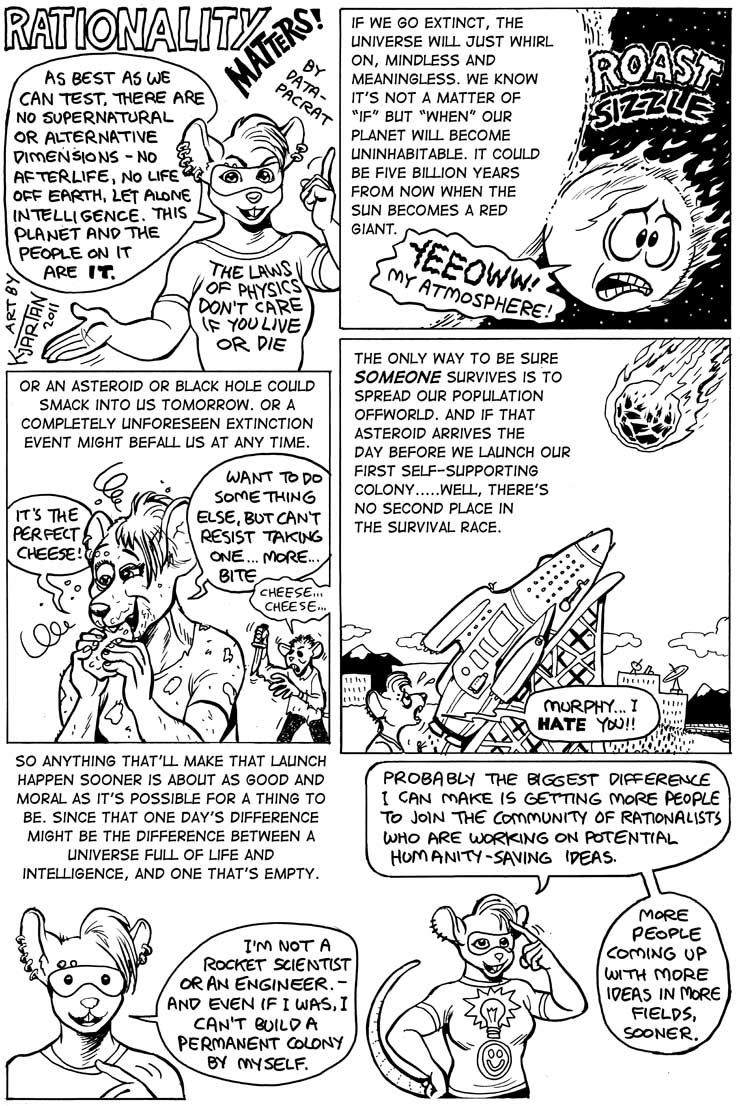
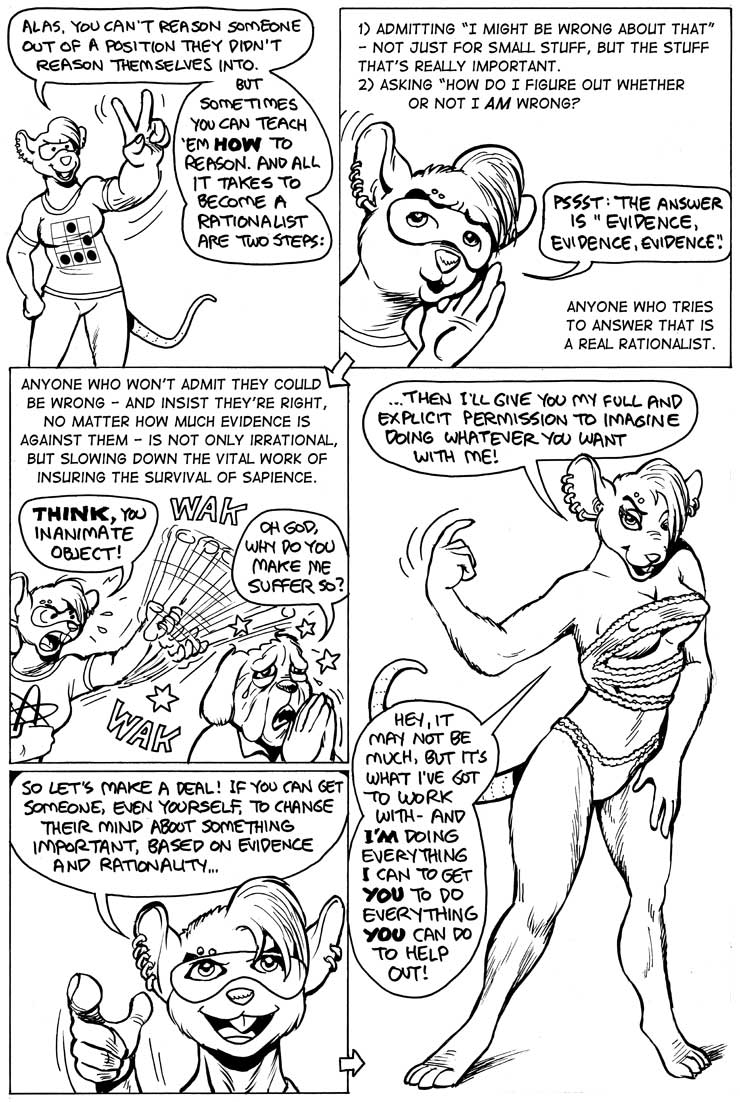 ]]>
]]>Live expectancy is now well over double what it was for the Medieval Briton, and knocking hard on triple’s door.
What for the future? Extreme life extension is no more inherently ridiculous than human flight or the ability to speak to a person on the other side of the world. Science isn’t magic – and ageing has proven to be a very knotty problem – but science has overcome knotty problems before.
A genuine way to eliminate or severely curtail the influence of ageing on the human body is not in any sense inherently ridiculous. It is, in practice, extremely difficult, but difficult has a tendency to fall before the march of progress. So let us consider what implications a true and seismic advance in this area would have on the nature of human life.
One absolutely critical issue that would surround a breakthrough in this area is the cost. Not so much the cost of research, but the cost of application. Once discovered, is it expensive to do this, or is it cheap? Do you just have to do it once? Is it a cure, or a treatment?
If it can be produced cheaply, and if you only need to do it once, then you could foresee a future where humanity itself moves beyond the ageing process.
The first and most obvious problem that would arise from this is overpopulation. A woman has about 30–35 years of life where she is fertile, and can have children. What if that were extended to 70–100 years? 200 years?
Birth control would take on a vastly more important role than it does today. But then, we’re not just dropping this new discovery into a utopian, liberal future. We’re dropping it into the real world, and in the real world there are numerous places where birth control is culturally condemned. I was born in Ireland, a Catholic nation, where families of 10 siblings or more are not in any sense uncommon.
What of Catholic nations – including some staunchly conservative, and extremely large Catholic societies in Latin America – where birth control is seen as a sin?
Of course, the conservatism of these nations might (might) solve this problem before it arises – the idea of a semi-permanent extension of life might be credibly seen as a deeper and more blasphemous defiance of God than wearing a condom.
But here in the West, the idea that we are allowed to choose how many children we have is a liberty so fundamental that many would baulk to question it.
We may have to.
There is another issue. What about the environmental impact? We’re already having a massive impact on the environment, and it’s not looking pretty. What if there were 10 times more of us? 100 times more? What about the energy consumption needs, in a world running out of petrol? The food needs? The living space? The household waste?
There are already vast flotillas of plastic waste the size of small nations that float across the surface of the Pacific. Carbon dioxide levels in the atmosphere have just topped 400 parts per million. We are pushing hard at the envelope of what the world of capable of sustaining, and a massive boost in population would only add to that ever-increasing pressure.
Of course, science might well sort out the answer to those things – but will it sort it out in time? The urgency of environmental science, and cultural change, suddenly takes on a whole new level of importance in the light of a seismic advance in addressing the problem of human ageing.
These are problems that would arise if the advance produced a cheap treatment that could (and would) be consumed by very large numbers of people.
But what if it wasn’t a cure? What if it wasn’t cheap? What if it was a treatment, and a very expensive one?
All of a sudden, we’re looking at a very different set of problems, and the biggest of all centres around something Charlie Chaplin said in the speech he gave at the end of his film, The Great Dictator. It is a speech from the heart, and a speech for the ages, given on the eve of mankind’s greatest cataclysm to date, World War 2.
In fact, you’d be doing yourself a favour if you watched the whole thing, it is an astounding speech.
The quote is this:
“To those who can hear me, I say — do not despair.
The misery that is now upon us is but the passing of greed, the bitterness of men who fear the way of human progress. The hate of men will pass, and dictators die, and the power they took from the people will return to the people. And so long as men die, liberty will never perish.”
And so long as men die, liberty will never perish.
What if Stalin were immortal? And not just immortal, but immortally young?
Immortally vigourous, able to amplify the power of his cult of personality with his literal immortality.
This to me seems a threat of a very different kind, but of no less importance, than the dangers of overpopulation. That so long as men die, liberty will never perish. But what if men no longer die?
And of course, you could very easily say that those of us lucky enough to live in reasonably well-functioning democracies wouldn’t have to worry too much about this. It doesn’t matter if you live to be 1000, you’re still not getting more than 8 years of them in the White House.
But there is something in the West that would be radically changed in nature. Commercial empires.
What if Rupert Murdoch were immortal?
It doesn’t matter how expensive that treatment for ageing is. If it exists, he’d be able to afford it, and if he were able to buy it, he’d almost certainly do so.
If Fox News was run by an immortal business magnate, with several lifetimes worth of business experience and skill to know how to hold it all together, keep it going, keep it growing? What then?
Not perhaps the sunny utopia of a playground of immortals that we might hope for.
This is a different kind of issue. It’s not an external issue – the external impact of population on the environment, or the external need of a growing population to be fed. These problems might well sink us, but science has shown itself extremely adept at finding solutions to external problems.
What this is, is an internal problem. A problem of humanity. More specifically, the fact that extreme longevity would allow tyranny to achieve a level of entrenchment that it has so far never been capable of.
But then a law might be passed. Something similar to the USA’s 8 year term limit on Presidents. You can’t be a CEO for longer than 30 years, or 40 years, or 50. Something like that might help, might even become urgently necessary over time. Forced retirement for the eternally young.
Not an unproblematic idea, I’m sure you’ll agree. Quite the culture shock for Western societies loathe to accept government intervention in private affairs.
But it is a new category of problem. A classic problem of humanity, amplified by immortality. The centralisation of control, power and influence in a world where the people it centres upon cannot naturally die.
This, I would say, is the most obvious knotty problem that would arise, for humanity, in the event of an expensive, but effective, treatment for ageing.
But then, let’s just take a quick look back at the other side of the coin. Is there a problem inherent in humanity that would be amplified were ageing to be overcome, cheaply, worldwide?
Let me ask you a question.
Do people, generally speaking, become more open to new things, or less open to new things, as they age?
Do older people – just in general terms – embrace change or embrace stasis?
Well, it’s very obvious that some older people do remain young at heart. They remain passionate, humble in their beliefs, they are open to new things, and even embrace them. Some throw the influence and resources they have accrued throughout their lifetimes into this, and are instrumental to the march of progress.
More than this, they add a lifetime of skill, experience and finesse to their passion, a melding of realism and hope that is one of the most precious and potent cocktails that humanity is capable of mixing.
But we’re not talking about the few. We’re talking about the many.
Is it fair to say that most older people take this attitude to change? Or is it fairer to say that older people who retain that passion and spark, who not only have retained it, but have spent a lifetime fuelling it into a great blaze of ability and success – is it fair to say that these people are a minority?
I would say yes. They are incredibly precious, but part of that preciousness is the fact that they are not common.
Perhaps one day we will make our bodies forever young. But what of our spirit? What of our creativity?
I’m not talking about age-related illnesses like Parkinson’s, or Alzheimer’s disease. I’m talking about the creativity, passion and fire of youth.
The temptation of the ‘comfort zone’ for all human beings is a palpable one, and one that every person who lives well, who breaks the mold, who changes the future, must personally overcome.
Do the majority of people overcome it? I would argue no. And more than this, I would argue that living inside a static understanding of the world – even working to protect that understanding in the face of naked and extreme challenges from reality itself – is now, and has historically been, through all human history, the norm.
Those who break the mold, brave the approbation of the crowd, and look to the future with wonder and hope, have always been a minority.
Now add in the factor of time. The retreat into the comforting, the static and the known has a very powerful pull on human beings. It is also not a binary process, but an analogue process – it’s not just a case of you do or you don’t. There are degrees of retreat, extremes of intellectual conservatism, just as there are extremes of intellectual curiosity, and progress.
But which extremes are the more common? This matters, because if all people could live to 200 years old or more, what would that mean for a demographic shift in cultural desire away from change and toward stasis?
A worrying thought. And it might seem that in the light of all this, we should not seek to open the Pandora’s box of eternal life, but should instead stand against such progress, because of the dangers it holds.
But, frankly, this is not an option.
The question is not whether or not human beings should seek to conquer death.
The question is whether or not conquering death is possible.
If it is possible, it will be done. If it is not, it will not be.
But the obvious problem of longevity – massive population expansion – is something that is, at least in principle, amenable to other solutions arising from science as it now practiced. Cultural change is often agonising, but it does happen, and scientific progress may indeed solve the issues of food supply and environmental impact. Perhaps not, but perhaps.
At the very least, these sciences take on a massively greater importance to the cohesion of the human future than they already have, and they are already very important indeed.
But there is another, deeper problem of a very different kind. The issue of the human spirit. If, over time, people (on average) become more calcified in their thinking, more conservative, less likely to take risks, or admit to new possibilities that endanger their understanding, then longevity, distributed across the world, can only lead to a culture where stasis is far more valued than change.
Pandora’s box is already open, and its name is science. Whether it is now, or a hundred years from now, if it is possible for human beings to be rendered immortal through science, someone is going to crack it.
We cannot flinch the future. It would be churlish and naive to assume that such a seemingly impossible vision will forever remain impossible. Not after the last century we just had, where technological change ushered in a new era, a new kind of era, where the impossibilities of the past fell like wheat beneath a scythe.
Scientific progress amplifies the horizon of possible scientific progress. And we stand now at a time when what it means to be a human – something which already undergone enormous change – may change further still, and in ways more profound than any of us can imagine.
If it can be done, it will be done. And so the only sane approach is to look with clarity at what we can see of what that might mean.
The external problems are known problems, and we may yet overcome them. Maybe. If there’s a lot of work, and a lot of people take a lot of issues a lot more seriously than they are already doing.
But there is a different kind of issue. An issue extending from human nature itself. Can we overcome, as a people, as a species, our fear, and the things that send us scurrying back from curiosity and hope into the comforting arms of wilful ignorance, and static belief?
This, in my opinion, is the deepest problem of longevity. Who wants to live forever in a world where young bodies are filled with withered souls, beaten and embittered with the frustrations of age, but empowered to set the world in stone to justify them?
But perhaps it was always going to come to this. That at some point technological advancement would bring us to a kind of reckoning. A reckoning between the forces of human fear, and the value of human courage.
To solve the external problems of an eternal humanity, science must do what science has done so well for so long – to delve into the external, to open up new possibilities to feed the world, and balance human presence with the needs of the Earth.
But to solve the internal problems of an eternal humanity, science needs to go somewhere else. The stunning advances in the understanding of the external world must begin to be matched with new ways of charting the deeps of human nature. The path of courage, of open-mindedness, of humility, and a willingness to embrace change and leave behind the comforting arms of old static belief systems – this is not a path that many choose.
But many more must choose it in a world of immortal people, to counterbalance the conservatism of those who fail the test, and retreat, and live forever.
Einstein lived to a ripe old age, and never lost his wonder. Never lost his humility, or his courage to brave the approbation and ridicule of his peers in that task he set himself. To chart the deep simplicities of the real, and know the mind of God. The failure of the human spirit is not written in the stars, and never will be.
We are none of us doomed to fail in matters of courage, curiosity, wonder or hope. But we are none of us guaranteed to succeed.
And as long as courage, hope and the ability to break new ground remain vague, hidden properties that we squeamishly refuse to interrogate, each new generation will have to start from scratch, and make their own choices.
And in a world of eternal humans, if any individual generation fails, the world will be counting that price for a very long time.
It is a common fear that if we begin to make serious headway into issues normally the domain of the spiritual, we will destroy the mystique of them, and therefore their preciousness.
Similar criticisms were, and sometimes still are, laid at the feet of Darwin’s work, and Galileo’s. But the fact is that an astronomer does not look to the sky with less wonder because of their deeper understanding, but more wonder.
Reality is both stunningly elegant, and infinitely beautiful, and in these things it is massively more amazing than the little tales of mystery humans have used to make sense of it since we came down from the trees.
In the face of a new future, where the consequences of human courage and human failure are amplified, the scientific conquest of death must be fused with another line of inquiry. The scientific pioneering of the fundamental dynamics of courage in living, and humility to the truth, over what we want to believe.
It will never be a common path, and no matter how clear it is made, or how wide it is opened, there will always be many who will never walk it.
But the wider it can be made, the clearer it can be made, the more credible it can be made as an option.
And we will need that option. We need it now.
And our need will only grow greater with time.
]]>